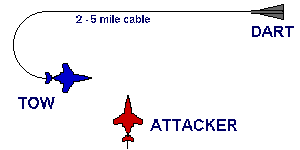 The dart resembled a paper airplane, except it was made from aluminim-skinned plywood and was about ten feet ( 3m. ) long, with four fins; "wing"span of about five feet. Usually performed over water, a gun pass went like this:
The dart resembled a paper airplane, except it was made from aluminim-skinned plywood and was about ten feet ( 3m. ) long, with four fins; "wing"span of about five feet. Usually performed over water, a gun pass went like this:
The tow plane travelled a few miles ahead of the attacker, releasing the dart, and unreeling the five miles or so of steel cable attaching the dart to the reel. Upon signal, the tow plane snapped a 180-degree turn, heading back into the path of the attacker. ( The dart continued on it's tether line. )
 When the tow jet passed the attacker, he was free to lockon and fire at the dart. ( This method ensured the tow plane was out of the field-of-fire.) As long as the 20mm didn't cut the wire, the dart could be reeled back in, and cut loose in a safe area just before landing; the dart was then recovered and scored by counting the holes or other damage inflicted by the 20mm. Some darts had a flare attached to one wing; these were used as IR sources enabling AIM-9 Sidewinder missile practice.
When the tow jet passed the attacker, he was free to lockon and fire at the dart. ( This method ensured the tow plane was out of the field-of-fire.) As long as the 20mm didn't cut the wire, the dart could be reeled back in, and cut loose in a safe area just before landing; the dart was then recovered and scored by counting the holes or other damage inflicted by the 20mm. Some darts had a flare attached to one wing; these were used as IR sources enabling AIM-9 Sidewinder missile practice.

( Side note: This jet - 68-0507 - always had a great radar. It once performed the "impossible", knocking a tiny little supersonic firebee drone out of the sky with an inert-warhead AIM-7 missile. During that 1976 William Tell competition, it literally destroyed three normally-reuseable firebee drones using AIM-7s, and easily won the missile shoot. )
This page hosted by  Get your own Free Home Page
Get your own Free Home Page
Just a Test : 


 Did the wings fold on the F-4E, as they did on Naval F-4s ?
Did the wings fold on the F-4E, as they did on Naval F-4s ? Later, a gun blast diffuser was added, and it extended another 18 inches or so.
Later, a gun blast diffuser was added, and it extended another 18 inches or so.  The dart resembled a paper airplane, except it was made from aluminim-skinned plywood and was about ten feet ( 3m. ) long, with four fins; "wing"span of about five feet. Usually performed over water, a gun pass went like this:
The dart resembled a paper airplane, except it was made from aluminim-skinned plywood and was about ten feet ( 3m. ) long, with four fins; "wing"span of about five feet. Usually performed over water, a gun pass went like this: When the tow jet passed the attacker, he was free to lockon and fire at the dart. ( This method ensured the tow plane was out of the field-of-fire.) As long as the 20mm didn't cut the wire, the dart could be reeled back in, and cut loose in a safe area just before landing; the dart was then recovered and scored by counting the holes or other damage inflicted by the 20mm. Some darts had a flare attached to one wing; these were used as IR sources enabling AIM-9 Sidewinder missile practice.
When the tow jet passed the attacker, he was free to lockon and fire at the dart. ( This method ensured the tow plane was out of the field-of-fire.) As long as the 20mm didn't cut the wire, the dart could be reeled back in, and cut loose in a safe area just before landing; the dart was then recovered and scored by counting the holes or other damage inflicted by the 20mm. Some darts had a flare attached to one wing; these were used as IR sources enabling AIM-9 Sidewinder missile practice.